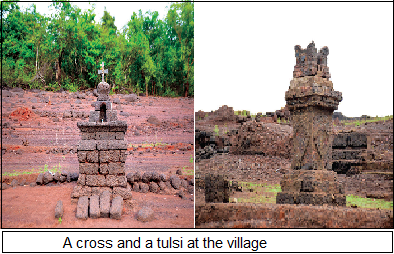Kurdi was once a bustling village. Then, the Selaulim dam came along, displacing its residents. STOI goes to the village that shows up in summer.
By : Govind Maad
Once I was sitting on the parapet of the Someshwar temple in our home village, Kurdi, when I was rudely asked to get down from there and sit on the step below. Why? I failed to understand…” Kishori Amonkar, one of India’s renowned classical singers and daughter of the legendary Mogubai Kurdikar, is quoted as having said this in an article profiling her life and work. Amonkar may have been speaking of the prejudices she suffered on account of her devdasi lineage, but the reference to Someshwar temple of Kurdi serves as a flashback to the lost village — the village that now lies submerged underwater for over ten months of the year — and the past culture and civilization.
The villagers of Kurdi and Selaulim, over 3,000 in number, got displaced from their roots after the villages came under the reservoir submergence of the Salaulim irrigation project. A dream project of the first chief minister of Goa, Dayanand Bandodkar, the Selaulim dam was conceptualized in 1965. Once the work on the dam finally started in 1977, the villagers of these two villages left their hearth and home to be rehabilitated in remote Valkini and Vaddem. While most of Kurdi resurfaces for a brief while once the water level goes down during summer, no trace can be found of the erstwhile Selaulim village, where the dam now stands majestically.
Jagannath Prabhudessai, who spent his childhood days in his Kurdi home, was pursuing his higher secondary studies at the time of displacement. Speaking to STOI, Prabhudessai says that the locals offered not much resistance to their displacement as those were “different times, different circumstances”. “This was a few years after Liberation, and people yearned for development. Then chief minister Bandodkar had held aloft a dream of development for Goa. The culture of protests and agitations that one can see now was not at all prevalent at that time. People had faith in Bandodkar and the project took off without much resistance,” Prabhudessai, whose family owned huge acres of land in the village, says. The relics of the ancient Someshwar temple, famously referred to by Amonkar, along with the vestiges of the entire submerged village, resurface during the summer months of April and May, before going under water once the monsoon sets in.
While most of the part of the heritage Someshwar temple was relocated before displacement, the ‘Swyambhu’ linga and the sanctum sanctorum of the temple have remained intact, even after over 30 years of submergence. The natives of Kurdi came together last year and built a shed for the temple. This year, they held a day-long get-together on May 21 and plan to make it an annual affair. “This is the only time of the year that Lord Someshwar resurfaces to offer darshan to his bhakts here. The programme enables the original Kurdikars to soak in nostalgia and get connected to their roots,” says Ajay Kurdikar, whose family migrated from Kurdi when he was 14.

The Catholic community also gets together at Kurdi every year at the spot where a church once stood. A small chapel has now been built at the site. The remains of a high school can also be seen by the side of the chapel. An RCC building that once housed a police outpost, a grocery shop, a teashop, etc, is another landmark that bears telltale marks of the Portuguese era. “This building,” points out Prabhudessai, “was built by my father in 1950. Post Liberation, the Goa government took it on rent for a police outpost. The outpost was functioning from this one-room tenement.” Asmall military camp also existed in the village during the Portuguese era. “This structure having a plinth area of nearly 1,000 sq m, was owned by us. We had an agreement with the Portuguese government that the structure would be handed over back to us once they vacated the premises. But we had to fight it out in court to get the structure back. We then used it as a godown to store our agricultural produce,” reminisces Prabhudessai.
The main tarred road that still lies intact despite having been under water for over three decades, intricately built culverts, and well-designed nallahs, are a pointer to the high standards of construction prevalent at that time. “Kurdi was a self-sustainable village with agriculture being the backbone of its sound rural economy. Displaced though we are from our birthplace, the emotional bond with our village will last for a lifetime,” says Prabhudessai.
Featured in The Times of India, Goa Edition on 22nd May, 2016

Leave a comment